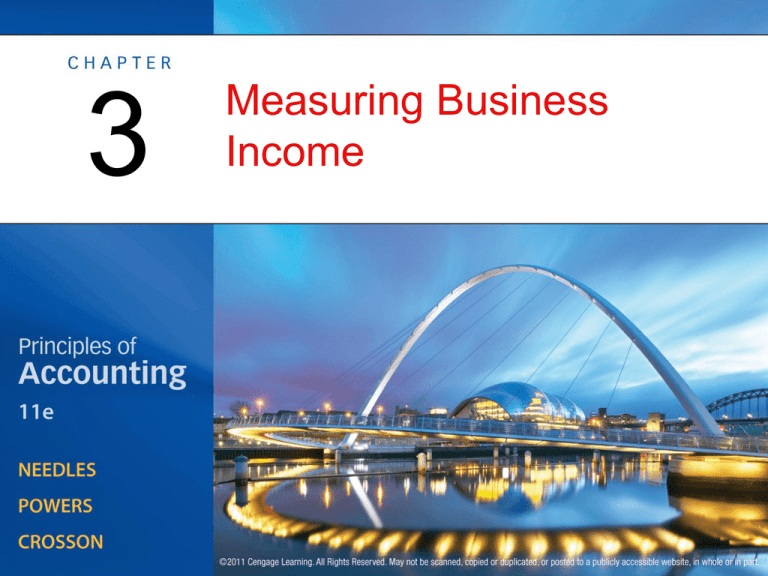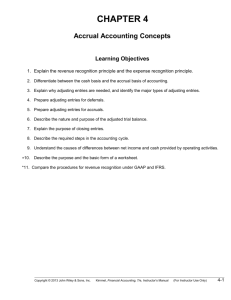
3
Measuring Business
Income
Profitability Measurement: Issues and
Ethics
OBJECTIVE 1: Define net income, and
explain the assumptions underlying income
measurement and their ethical application.
Figure 1: Assumptions and the Matching
Rule
Profitability Measurement: Issues and
Ethics
• Net income is the excess of revenues over
expenses; net loss is the reverse. Net income is
net increase in owner’s equity from co’s
operations.
• Revenues are increases in owner’s equity
resulting from selling goods, rendering
services, or performing other business
activities.
Profitability Measurement: Issues and
Ethics
• Expenses are the decreases in owner’s equity
resulting from the cost of selling goods or
rendering services in the course of earning
revenue.
• The continuity assumption states that when
measuring income, in the absence of evidence to
the contrary, the accountant should assume that
a business will continue to operate indefinitely.
Profitability Measurement: Issues and
Ethics
• The periodicity issue recognizes that the
measurement of net income for a given period
is at best an estimate.
• A fiscal year is any 12-month period; it may or
may not correspond to the calendar year.
Profitability Measurement: Issues and
Ethics
• Under the cash basis of accounting,
revenues and expenses are recognized
(recorded) when cash is received or paid.
Profitability Measurement: Issues and
Ethics
• According to the matching rule, revenues are
recorded in the accounting period in which they
are earned, and expenses are recorded in the
same accounting period as the revenue
generated by the particular expense; the timing
of cash receipts and payments is irrelevant.
Profitability Measurement: Issues and
Ethics
• Earnings management is the manipulation of
revenues and expenses to achieve a specific
outcome. While not illegal within small ranges,
larger variations can mislead the user and lead
to fraudulent financial reporting.
©2011 Cengage Learning All Rights Reserved. May not be scanned, copied or duplicate, or posted to a publicly accessible website, in whole or in part.
Accrual Accounting
OBJECTIVE 2: Define accrual accounting,
and explain how it is accomplished.
Accrual Accounting
• Accrual accounting consists of all the
techniques used to apply the matching rule.
– When a revenue is recorded before cash is received, a
receivable is also recorded.
– When an expense is recorded before cash is paid, a
payable is also recorded.
Accrual Accounting
• Accrual accounting consists of all the techniques
used to apply the matching rule.
– Adjusting entries are required when
(1) recorded costs have to be allocated between two
or more accounting periods,
(2) unrecorded expenses exist,
(3) recorded unearned revenues must be allocated
between two or more accounting periods, and
(4) unrecorded revenues exist.
Accrual Accounting
• Determining when revenue is earned is
known as revenue recognition.
Accrual Accounting
• The SEC stated that all the following conditions
must exist before revenue is recognized:
– Persuasive evidence of an arrangement exists.
– A product or service has been delivered.
– The seller’s price to the buyer is fixed or
determinable.
– Collectibility is reasonably assured.
Accrual Accounting
• Adjusting entries ensure that transactions
appear in the proper accounting period.
• Adjusting entries do not affect cash flow
because they never involve the Cash
account, but they are important for the
accurate measure of performance.
Exhibit 1: Trial Balance
SE 1
©2011 Cengage Learning All Rights Reserved. May not be scanned, copied or duplicate, or posted to a publicly accessible website, in whole or in part.
The Adjustment Process
OBJECTIVE 3: Identify four situations that
require adjusting entries, and illustrate
typical adjusting entries.
The Adjustment Process
• Adjusting entries are made at the end of the period.
– A deferral is the postponement of the recognition of
revenue received in advance or of an expense already
paid (cash has already changed hands).
• Allocate recorded costs between two or more accounting
periods.
• Allocate recorded, unearned revenues between two or
more accounting periods.
The Adjustment Process
• Adjusting entries are made at the end of the period.
– An accrual is the recognition of a revenue or expense
that has arisen but has not yet been recorded (cash
has not yet changed hands).
• Recognize unrecorded expenses.
• Recognize unrecorded, earned revenues.
Figure 2: The Four Types of Adjustments
Figure 3: Adjustment for Prepaid
(Deferred) Expenses
Figure 4: Adjustment for Unrecorded
(Accrued) Expenses
Figure 5: Adjustment for Unearned
(Deferred) Revenues
Figure 6: Adjustment for Unrecorded
(Accrued) Revenues
The Adjustment Process
• Prepaid rent and prepaid insurance are
transferred (at least in part) to expense accounts.
The Adjustment Process
• Office supplies used are recorded as Office
Supplies Expense. Usually an inventory of office
supplies is taken to calculate the cost of supplies
used.
The Adjustment Process
• Depreciation on buildings and equipment must be
recorded.
– Depreciation is the logical allocation of asset cost to the
accounting periods benefited.
– Depreciation Expense is a temporary account used to record
depreciation during a given accounting period.
Accumulated Depreciation is a permanent account that
shows the total depreciation recorded in all prior periods.
– Show the balance sheet presentation of the Accumulated
Depreciation account.
The Adjustment Process
The Adjustment Process
• Accrued expenses (expenses incurred but not
paid) are recorded. Examples are accrued interest,
wages, and taxes.
• Unearned revenues (liabilities) are transferred
(at least in part) to earned revenues.
• Accrued revenues (revenues earned but not
received) are recorded.
The Adjustment Process
The Adjustment Process
The Adjustment Process
©2011 Cengage Learning All Rights Reserved. May not be scanned, copied or duplicate, or posted to a publicly accessible website, in whole or in part.
Using the Adjusting Trial Balance to
Prepare Financial Statements
OBJECTIVE 4: Prepare financial statements
from an adjusted trial balance.
Using the Adjusting Trial Balance to
Prepare Financial Statements
• An adjusted trial balance is prepared after all
the adjusting entries have been posted to the
ledger.
• Once the adjusted trial balance is in balance, the
financial statements can be prepared.
Exhibit 2: Relationship of the Adjusted
Trial Balance to the Income Statement
Exhibit 3: Relationship of the Adjusted Trial
Balance to the Balance Sheet and Statement of
Owner’s Equity
©2011 Cengage Learning All Rights Reserved. May not be scanned, copied or duplicate, or posted to a publicly accessible website, in whole or in part.
Cash Flows from Accrual-Based
Information
OBJECTIVE 5: Use accrual-based
information to analyze cash flows.
Cash Flows from Accrual-Based
Information
• Accrual-based net income indicates whether
management has met its profitability goal.
• Cash flow measures liquidity.
• Cash paid (received) equals maximum possible
cash payments (or receipts) minus cash not paid
(or received) this period.
Supplies had a balance of $400 at the end of May, and $300 at the end of
June. Supplies Expense was $550 for the month of June. How much cash
was paid for Supplies during June?
Ending Balance of Supplies (6/30)
$360.
Supplies Expenses during June
550.
Maximum Cash Pymts for Supp.
$910.
Less Beg. Bal of Supplies (5/31)
400.
Cash paid for Supplies during June
$510.
©2011 Cengage Learning All Rights Reserved. May not be scanned, copied or duplicate, or posted to a publicly accessible website, in whole or in part.












